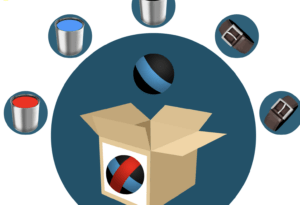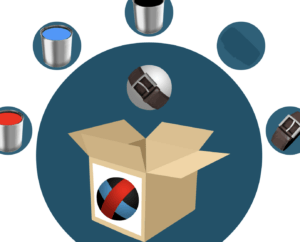For this week’s critical play, I played Factory Balls! Factory Balls is a problem-solving mystery video game that simulates one’s own logical reasoning, deduction, and decision-making skills. It was developed by Bart Bonte in 2008, who is a famous video game developer known for fun, interactive abstract puzzle games. The game was hosted across various platforms including iOS/OS, Desktop, Android, and Windows. Given the game’s mechanics, I believe it is best played in a mobile or tablet environment due to the limited, number of user interactions and larger focus on the impact of such actions on the logical outcome. It is a challenge and discovery driven brain game, rather than an immersive or experiential one. So, how does it work?
In Factory Balls, a user is shown a box with a desired design that they must replicate. The user has a palette of tools they can use: belts, hats, goggles, and more which can all mask or interlay colors based on sequential use. The tools when used in the correct order will allow the initial plain ball to match the goal design, and the user can then move on to the next level! The game design is abstract, but intuitive enough to pick up within 60 seconds via trial-and-error approaches. It’s a simple game, so let’s jump into the mechanics and logical puzzles that make this game so interesting! There are three specific sub-mechanics of the game that play into the central experience of trial-and-error and rapid gameplay experimentation: Pattern and Shape Recognition or Manipulation, Level Progression, and Resets.
When playing Factory Balls, there are distinct emergent patterns and specialized functions that specific tools have. For example, a hat of a particular size can mask a part of the ball or a belt can mask a specific strip of the ball. When used in conjunction with one another, players understand sequential patterns or designs that one can create as a function of several distinct, unique tools. Consider Design A shown below (namely, a black ball with a blue strip on it).

This design is a direct function of respectively painting the ball blue, using the belt to mask the stripe, and then painting the ball black. I found this design pattern by simply running rapid experiments with multiple designs, testing out the effect of various tools with the paints at hand. Shown below is a live action shot of one such experiment!

However, the rapid experimentation soon evolved into careful, logical consideration for what sequences I must follow to create specific design patterns. It forced me to reckon with the unique ordering of my actions, which logically was difficult to trace through as we tend to defer to immediate action to solve mental puzzles rather than logical brain work. For example, a research study in HCI showed how many expert Tetris players would flip a tile more times than necessary to get to their final solution (namely, they wouldn’t take the shortest path). Design A is an example of this. It is this inverted, sequential thinking in gameplay that really exercised my brain, along with the fact that this was an identifiable, repeatable pattern that I learned how to create. As the levels got more difficult, I found myself leveraging such design functions and patterns I knew how to create from prior levels to solve more complex designs. Along with the fact that I could always go back to the initial plain ball, the game was super fun to play and to understand my own logical deficiencies (identifying and stopping when I was running in logical circles or not making any progress).
However, some may say that Factory Balls from a UI/UX is too simple and that the UI/UX may be too static, and out-dated based on the level of design complexity/richness of its competitors. For example, there are evident latency delays when moving through the application and the backgrounds/designs of the UI/UX aren’t particularly memorable (namely, the white static background). To this, I actually claim that the shortcomings of this gameplay experience are actual strengths: the “less is more” design aesthetic in a time where game designers tend to add, add, add is ironically rewarding and refreshing to see as a gamer. One future improvement I’d make is to provide “hints” that are timed to appear based on the number of attempts or interactions the user has on a particular level. For instance, there were multiple levels of difficulty where I wanted to rage quit as my logical reasoning stamina was simply exhausted, or I was experiencing circular thinking.



